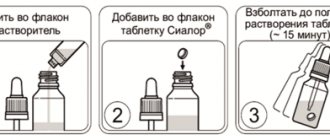Release form, packaging and composition of the drug Clinical-pharmacological group Pharmaco-therapeutic group Pharmacological action Indications for use Method of administration and doses Side effects Contraindications for use Use in children Special instructions Drug interactions
Registration Certificate Holder:
F.Hoffmann-La Roche, Ltd. (Switzerland)
ATX Code:
P01BD51
Active substance:
pyrimethamine
Dosage form:
Fansidar
| The drug is available with a prescription | Fansidar | Tablets reg. No.: P N014161/01 dated 06.10.08 - Cancellation of State. registration |
Pharmacodynamics and pharmacokinetics
Pharmacodynamics
The active substance acts on the asexual forms of malarial plasmodia found inside red blood cells . The effectiveness is explained by the synergistic action of the components of the drug - the activity of two enzymes necessary for the synthesis of folinic acid in parasites is suppressed. This drug is active against strains that are resistant to the action of chloroquine . There are strains of P. Falciparum that are resistant to this drug. Effectiveness has been noted against infection caused by Toxoplasma gondii .
Pharmacokinetics
After oral administration, maximum concentrations are reached after 4 hours. The active substances are 90% protein bound. Both penetrate the placental barrier and are excreted in the milk of lactating women. Pyrimethamine is biotransformed to several metabolites. Characterized by a long half-life - for pyrimethamine 100 hours, for sulfadoxine - 200 hours. Both components are excreted by the kidneys. In patients with malaria, the pharmacokinetics of the drug differs from that in healthy people. In case of renal failure, a slowdown in excretion is observed.
Pharmacological action of Fansidar
According to the instructions, Fansidar has antiprotozoal and antimalarial effects. The active components of the drug are active against asexual intraerythrocytic forms of malarial plasmodia (trophozoids, schizonts). The combined action of sulfadoxine and pyrimethamine inhibits the activity of two important enzymes that affect the biosynthesis of folinic acid in microorganisms. Parasites die after a single injection of Fansidar.
This medication is active against most strains of Plasmodium pathogenic to humans - P. vivax, P. Malariae, P. falciparum, P. ovale, including strains resistant to pyrimethamine and known 4-aminoquinoline derivatives.
However, in South America, Central and Eastern Africa, as well as in Southeast Asia, strains of P. falciparum with developed resistance to the active components of the drug Fansidar have been identified.
The drug is also effective against infectious diseases caused by Pneumocystis carinii and Toxoplasma gondii.
Side effects
- rash, itching;
- hair loss;
- hives;
- photosensitivity;
- erythema multiforme;
- exfoliative dermatitis ;
- leukopenia , megaloblastic , aplastic and hemolytic anemia ;
- nausea, loose stools, abdominal pain, pancreatitis , hepatitis ;
- depression , possible convulsions, hallucinations , insomnia , irritability;
- renal failure , toxic nephrosis , interstitial nephritis ;
- general and muscle weakness, fatigue, headaches .
Sulfonamides are similar in structure to diuretics and oral hypoglycemic agents. In this regard, hypoglycemia and polyuria .
Interaction of Fansidar with other drugs and special instructions
It is important that the drug is sold only with a doctor’s prescription and you should not take it yourself, although the instructions allow you to start taking it without a doctor’s prescription, but after that it is important to consult a specialist.
The drug is well tolerated by patients, side effects occur quite rarely, but there are conditions that can provoke increased side effects. This may include the simultaneous use of Fansidar with medications based on Chloroquine. Here the doctor must reconsider the basic methods of therapy. If the duration of treatment is more than three months, folic acid is necessary.
Fansidar, instructions for use (Method and dosage)
Fansidar tablets are taken after meals, whole, with a sufficient amount of liquid.
Treatment of uncomplicated malaria . Adults weighing more than 45 kg are prescribed 3 tablets once.
Children under 2 years old - 0.5 tablets, 10 - 14 years old - 2 tablets.
Treatment of complicated malaria . Start by taking quinine for a week, then take Fansidar once in the doses described above. Such sequential therapy prevents relapses that occur with treatment with quinine .
To prevent malaria, children under 2 years of age are prescribed 0.5 tablets, from 10 to 14 years of age - 1.5 tablets every 2 weeks. Adults are prescribed 1 tablet per week. The first dose is taken a week before departure and continued throughout the stay and for 1.5 months. after checkout. The duration of preventive treatment can be 2 years. There is no experience with longer-term use.
Fansidar for toxoplasmosis is prescribed 2 tablets once a week for 1.5 months. An alternative regimen can be the following: 1 tablet every 3 days, 8 tablets per cycle. It is necessary to carry out 2-3 cycles with a break of a month. Between cycles you need to take Folic acid , given the possibility of suppressing hematopoiesis.
In patients with latent toxoplasmosis, complex use with immunomodulators ( Polyoxidonium , Galovit ) is effective. After the first cycle, there is a significant decrease in IgM .
During treatment it is necessary to avoid exposure to the sun. If the drug is prescribed for 3 months, it is recommended to monitor blood counts and liver tests. Sore throat, cough, fever , shortness of breath , skin rash are the first signs of side effects and you should immediately stop taking the drug.
Purpose and characteristics of the drug
"Fansidar" is produced in the form of tablets and solution for injection. Fansidar tablets have the following composition:
- sulfadoxine, active ingredient;
- pyrimethamine, active ingredient;
- corn starch, excipient;
- lactose, excipient;
- talc, excipient;
- gelatin, excipient;
- magnesium stearate, excipient.
The effect of the drug is due to the main components included in its composition. It fights against malarial plasmodia that have entered the human body. It is also able to defeat infection caused by Toxoplasma.
Another form of release of the drug is an injection solution. It contains both active main substances.
The drug is quite effective against most strains that cause malaria. Some plasmodia die after the first dose of this drug. But there are also strains that are resistant to this drug. Therefore, the remedy should be prescribed by a doctor after a thorough examination.
Indications for prescribing this drug may be:
- Malaria and its prevention.
- Toxoplasmosis.
- Pneumocystis infection (the drug is used as a preventive measure).
For the treatment and prevention of malaria and infections against which the drug is effective, a course is carried out. The dosage is determined by the doctor according to age and indications. This medicine is usually taken after meals with plenty of regular drinking water. The duration of treatment is determined by the doctor; sometimes a single dose is enough. As a prophylactic measure, this drug should be taken during the entire stay in an area at risk of infection and upon return for some time. For children, it is possible to take the drug as a means of preventing pneumonia.
Fansidar reviews
Tropical malaria is imported by foreign citizens and our tourists. In January 2016 alone, 18 cases of malaria . Due to the progressive resistance of the malaria pathogen, monotherapy with drugs is not indicated. Therefore, it is more advisable to use either combination drugs (the drug Fansidar) or regimens that combine quinine and doxycycline or artemisinin and mefloquine . Those traveling to countries unaffected by malaria are prescribed preventive courses - a week before departure, the entire period of stay in a malarial area and another 1 month after departure (applies to delagil ). The drugs Lariam and Maloprim are taken for a total of up to 6 months.
The most common reviews are about the use of this drug for toxoplasmosis .
- “...Toxoplasmosis cannot be treated with this drug, but the doctor said that before pregnancy it is necessary to reduce antibody titers, so I take these pills.”
- “...I was undergoing treatment to prevent a miscarriage. When taking Fansidar, I had a cough and a severe sore throat.”
- “... I’ve been drinking for 12 days, I’m very weak, I’m constantly feeling sick and vomiting.”
- “... They prescribed me to take this drug, and after the 29th week I had to donate blood.”
- “... I was treated after I had a frozen pregnancy and was diagnosed with toxoplasmosis. After treatment, six months later I became pregnant, tests for toxoplasmosis were normal, and a healthy child was born.”
Contraindications and side effects
A strict contraindication for taking the drug will be the first trimester of pregnancy. It has been proven that pyrimethamine can harm the fetus in the first weeks. If pregnancy has already reached the second or third trimester, then the drug can be used, but only under the strict supervision of a doctor and if the benefits of Fansidar exceed all possible risks.
Contraindications also include:
- Age restrictions: the drug is not used in infants.
- Allergy, individual intolerance or hypersensitivity to sulfonamides.
- Some serious diseases of the liver, kidneys, and hematopoietic system.
- Pregnancy and breastfeeding period. This is not a strict contraindication, with the exception of the first trimester. Moreover, during the period of Fansidar therapy, it is worth strengthening contraceptive measures, since conception during this period is highly undesirable.
Doctors and patients who have undergone therapy with this drug say that Fansidar is easily tolerated in the doses usually prescribed by doctors. But sometimes some side effects are possible, which are expressed as:
- Certain allergic skin reactions: itching, redness, rash and hair loss.
- Nausea, vomiting, stomatitis, hepatitis.
- Anemia, thrombocytopenia.
- Headaches, weakness, cough.
An overdose of the drug can provoke a sharp manifestation of some of the above effects: nausea, vomiting and even convulsions.
What are generic drugs
Generic drug, which means generic, is a medicinal product that basically has the same quantity and quality of the active substance as in the original drug. It must be produced in the same dosage form as the standard. A prerequisite is the effectiveness of the generic.
After the invention of the drug, the company receives a patent for the original molecule of the active substance. Exclusive rights to production and sales are retained by the company for 20 years. After this, other pharmaceutical companies can produce generic versions of the drug. For example, there is an original Russian-made medicine, Arbidol. But in 2007 his patent expired. Therefore, generics Arpetol (Belarus) and Immunostat soon appeared.
They have the same international nonproprietary name (INN), but the manufacturer has the right to change the packaging and give his own trade name to the medicinal product. That's why Ibuprofen and its generic Nurofen are on sale.
Generics are subject to no less stringent requirements for quality and effectiveness. Despite the use of the same active ingredient, the effect on the body may differ. This is due to several factors:
- composition of excipients - they are used in any medicine, thanks to them you can give the form to a tablet, capsule or ointment, ensure rapid solubility or prolonged action;
- quality of raw materials - any pharmacological substance contains a certain proportion of impurities, the effect of the finished medicine depends on their quantity.
Analogues undergo a large number of tests. The pharmaceutical company that produces the generic must prove that its effect is equivalent to the original drug. Studies look at how quickly the drug is absorbed, what maximum concentration it reaches in the blood, and how quickly it is metabolized.
Some medicines are required to ensure that the therapeutic effect matches the original. In this case, they are not limited to laboratory confirmation of the concentration of the substance in the blood, but study the patient’s reaction.
More lenient requirements for drugs that are not absorbed into the blood. This group includes skin ointments and eye drops. In this case, it is enough for the pharmaceutical company to prove that the composition of the drug corresponds to the original.




